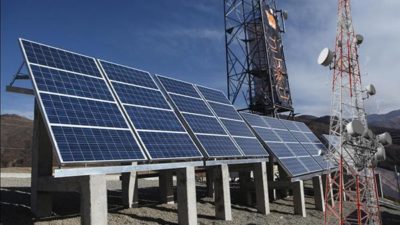
Telecom power systems assist telecommunication services in cases of grid power fluctuations and interruptions. The intersection of the telecom industry with information technology (IT) has resulted in the evolution of the telecom power systems market. The rising penetration of telecom towers in rural and off-grid areas and the recent disposition of small cell power systems used for LTE are predicted to fuel the demand for telecom power systems over the forecast period. The exponential growth of mobile data traffic and telecom operators has led to the development of network coverage in rural as well as metropolitan areas. The substantial use of mobile devices in urban areas has enhanced the incorporation of femtocells and picocells which need DC power systems. The rising adoption of hybrid power systems is estimated to contribute to the growth of telecom power systems over the forecast period. The lack of grid connectivity in rural areas is projected to stimulate vendors across the globe to implement hybrid systems as they involve energy-efficient and cost-effective solutions in light of the environmental concerns caused by the over-utilization of non-renewable sources to power telecom industries. Owing to the considerable decline in renewable energy sources across the globe, the cost structure for installation and the required equipment for hybrid system that is energy efficient and cost effective in comparison to traditional power supply systems.The increasing consumer inclination toward reducing the carbon imprint of the telecom industry and the expansion of telecom infrastructure to off-grid areas such as Africa and Asia are expected to create additional scope for the telecom power systems market.
The market has been segmented by grid type into the on-grid, off-grid, and bad grid divisions. Bad grid held the dominant market share in 2016 and is anticipated to retain its position over the forecast period. A majority of the population dwells in the rural areas devoid of telecommunication networks and electricity. The rising demand for grid-based power systems across these areas is likely to drive the telecom power systems market. Based on component, the telecom power systems market has been divided into the following categories: inverters, rectifiers, heat management systems, convertors, generators, and others. On the basis of power source, the market has been split into the following segments: diesel solar, diesel battery, diesel wind, and others. Diesel solar-based hybrid systems help decrease the cost of operation, maintenance, and logistics by reducing the runtime of diesel & fuel consumption. Government initiatives to promote solar PVs and the implementation of green telecom power solutions in multiple source-based systems are predicted to enhance the advancement of telecom power systems over the next few years.
Planning to lay down future strategy? Perfect your plan with our report sample here https://www.transparencymarketresearch.com/sample/sample.php?flag=S&rep_id=27146

In terms of geography, the telecom power systems market is distributed over North America, Europe, Asia Pacific, Middle East & Africa, and Latin America. Asia Pacific is likely to witness rapid growth over the forecast period, propelled by the growing infiltration of telecom towers in rural areas in order to widen the mobile connectivity and subscriber base in this region. Expansion of the LTE and 3G networks too has fuelled the need for telecom power systems in Asia Pacific. Europe constituted the dominant market share in 2016 and is likely to remain so over the forecast period. Implementation of green power alternatives to reduce operational costs, powering telecom sites and addressing the infrastructural changes mobile network companies in this region is expected to drive the market over the forecast period.
Developing economies is growing at an accelerating growth in the telecom sector as it demands for high infrastructural changes for reliability and cost effectiveness. Key players in the telecom power systems include GE Industrial Solutions, Huawei Technologies Co., Schneider Electric, Delta Electronics, Cummins Power Generation, Ascot Industrial srl, Myers Power Products, Eaton Corporation, Universal Power Drives, and Vertiv Co., among others.
The report offers a comprehensive evaluation of the market. It does so via in-depth qualitative insights, historical data, and verifiable projections about market size. The projections featured in the report have been derived using proven research methodologies and assumptions. By doing so, the research report serves as a repository of analysis and information for every facet of the market, including but not limited to: Regional markets, technology, types, and applications.
Looking for exclusive market insights from business experts? Request a Custom Report here https://www.transparencymarketresearch.com/sample/sample.php?flag=CR&rep_id=27146
The study is a source of reliable data on:
- Market segments and sub-segments
- Market trends and dynamics
- Supply and demand
- Market size
- Current trends/opportunities/challenges
- Competitive landscape
- Technological breakthroughs
- Value chain and stakeholder analysis
The regional analysis covers:
- North America (U.S. and Canada)
- Latin America (Mexico, Brazil, Peru, Chile, and others)
- Western Europe (Germany, U.K., France, Spain, Italy, Nordic countries, Belgium, Netherlands, and Luxembourg)
- Eastern Europe (Poland and Russia)
- Asia Pacific (China, India, Japan, ASEAN, Australia, and New Zealand)
- Middle East and Africa (GCC, Southern Africa, and North Africa)





